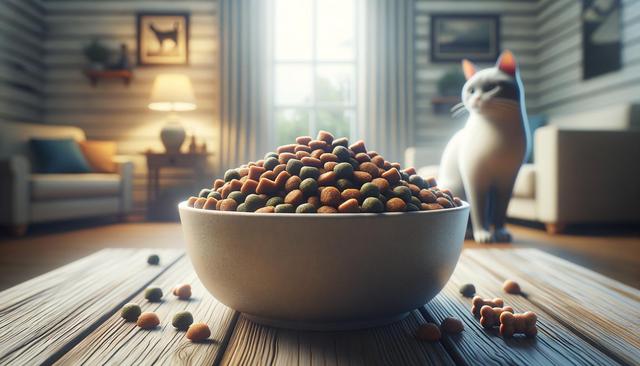Understanding the Nutritional Needs of Cats
Cats are obligate carnivores, which means their diet must consist primarily of animal-based proteins to thrive. This dietary need makes choosing the right cat food a critical part of pet ownership. Unlike omnivores, cats rely heavily on nutrients found only in meat, such as taurine, arachidonic acid, and vitamin A. When comparing different types of cat food, it’s important to read labels closely and ensure the ingredients support a balanced and species-appropriate diet.
Many pet owners aim to provide the best cat food available, but understanding what makes a product nutritious is the first step. Look for food that includes:
- High-quality animal protein as the first ingredient
- Limited fillers like corn and soy
- Essential fatty acids for skin and coat health
- Added vitamins and minerals
By meeting these criteria, you’ll be more likely to provide a diet that supports your cat’s energy levels, immune system, and overall well-being.
Exploring Fresh and Raw Cat Food Options
In recent years, fresh cat food and raw cat food diets have become more popular among pet owners seeking more natural feeding methods. These options often emphasize minimally processed ingredients and resemble a cat’s ancestral diet more closely than traditional kibble. Fresh cat food typically includes cooked meat, vegetables, and grains, while raw cat food may include uncooked meat, organs, and bones.
Benefits of these diets can include:
- Improved digestion and reduced stool odor
- Shinier coat and healthier skin
- Higher energy levels
- Fewer food allergies or intolerances
However, raw cat food requires careful handling to avoid bacterial contamination and may not be suitable for all cats, especially those with immune issues. Always consult a veterinarian before switching to a raw or fresh food diet to ensure it’s balanced and safe.
Convenient and Tasty Wet Food Options
Wet food remains a widely favored choice due to its high moisture content and palatable texture. Products like sheba cat food in gravy and sheba pate offer convenience and taste in one package. These foods are especially beneficial for cats who don’t drink enough water, as the added hydration supports urinary tract health. Moreover, wet food often appeals to picky eaters, making mealtime more enjoyable for both the pet and the owner.
When choosing wet food, consider the following factors:
- Protein percentage per serving
- Type of meat used (chicken, beef, fish, etc.)
- Grain-free or limited-ingredient formulas
- Artificial additives and preservatives
Sheba products, including those in gravy and pate form, are known for their rich texture and meat-forward recipes. While offering them occasionally as a treat or part of a rotational diet can be a good strategy, ensure your cat receives balanced nutrition across all meals.
Incorporating Technology into Feeding Time
Technology has transformed many aspects of pet care, including how we feed and monitor our cats. Devices like furbo for cats provide interactive features that allow owners to observe and engage with their pets remotely. While originally designed for dogs, many cat owners have adapted such cameras to check in during feeding times or monitor behavior when away from home.
Some key features of pet tech like Furbo include:
- Live video streaming with two-way audio
- Treat dispensing mechanisms
- Motion and sound alerts
- Night vision capabilities
These tools can be particularly useful for cats with medical conditions that require frequent monitoring or for pets that experience separation anxiety. Though not a substitute for in-person interaction, they add a layer of convenience and peace of mind for busy pet parents.
Making Informed Choices for Your Cat’s Diet
Choosing the right cat food involves more than just picking a bag off the shelf. With so many options available, from raw cat food to convenient wet meals like sheba cat food in gravy, it’s important to match your cat’s dietary needs and preferences. Fresh cat food may offer a wholesome, cooked alternative, while raw options can provide a diet closer to what cats would eat in the wild—if prepared safely and thoughtfully.
To make the most informed decision, consider:
- Your cat’s age, weight, and health conditions
- Activity level and lifestyle (indoor vs. outdoor)
- Allergies or food sensitivities
- Veterinarian recommendations
Rotating between different types of food can also prevent boredom and ensure a broader intake of nutrients. Whether you rely on dry kibble, fresh meals, or use tech gadgets like furbo for cats to enhance feeding routines, the goal is to support a long, healthy life for your feline companion.
Conclusion: Supporting Your Cat’s Well-Being Through Nutrition
Feeding your cat is more than a daily task—it’s a vital part of promoting health, longevity, and happiness. By exploring options like fresh cat food, raw diets, and popular wet foods such as sheba pate, you can tailor a regimen that suits your cat’s unique needs. Combining quality nutrition with modern tools like furbo for cats can further enhance your connection and care routine. Always prioritize informed choices and consult with professionals to ensure your feline friend receives the nourishment they deserve.




Leave a Reply